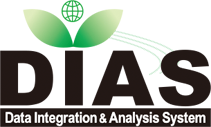


  |  |

| Name | AGURAM Ground Information Database |
| Edition | 1 |
| Abbreviation | AGURAM |
| DOI | doi:10.20783/DIAS.207 |
| Metadata Identifier | AGURAM_GI20230727070037-DIAS20221121113753-en |
| Name | Hiroyuki Miyazaki |
|---|---|
| Organization | Earth Observation Data Integration & Fusion Research Initiative (EDITORIA), University of Tokyo |
| Address | Cw-503 Institute of Industrial Science, University of Tokyo, 4-6-1 Komaba, Meguro-ku, Tokyo, 153-8505, Japan |
| TEL | +81-3-5452-6412 |
| FAX | +81-3-5452-6414 |
| heromiya@csis.u-tokyo.ac.jp |
| Name | DIAS Office |
|---|---|
| Organization | Japan Agency for Marine-Earth Science and Technology |
| Address | 3173-25, Showa-Cho, Kanazawa-ku, Yokohama-shi, Kanagawa, 236-0001, Japan |
| dias-office@diasjp.net |
| Name | Hiroyuki Miyazaki |
|---|---|
| Organization | Earth Observation Data Integration & Fusion Research Initiative (EDITORIA), University of Tokyo |
| heromiya@csis.u-tokyo.ac.jp |
| Name | Hiroyuki Miyazaki |
|---|---|
| Organization | Earth Observation Data Integration & Fusion Research Initiative (EDITORIA), University of Tokyo |
| heromiya@csis.u-tokyo.ac.jp |
creation : 2014-01-02
This dataset includes ground information derived by visual interpretation of satellite imageries taken by Advanced Spaceborne Thermal Emission and Reflection Radiometer (ASTER). The dataset consists of geometries of boundaries between urban and non-urban. Although the ground information dataset is originally developed for the ASTER Global URban Area Map (AGURAM; see details at https://eco.geogrid.org/), it will be a source of training and validation for satellite remote sensing applications, such as land cover classification and urban area mapping.
structure
| Begin Date | 2000-04-07 |
| End Date | 2008-03-31 |
| North bound latitude | -27.371628 |
| West bound longitude | -158.027344 |
| Eastbound longitude | 158.642439 |
| South bound latitude | 60.392148 |
| Dimension Name | Dimension Size (slice number of the dimension) | Resolution Unit |
|---|---|---|
| row | (deg) | |
| column | (deg) |
EPSG:4326
| Keyword Type | Keyword | Keyword thesaurus Name |
|---|---|---|
| theme | Urbanization, Land Cover | GEO_COP |
| Keyword Type | Keyword | Keyword thesaurus Name |
|---|---|---|
| theme | DIAS > Data Integration and Analysis System | No_Dictionary |
GEO Grid, National Institute of Advanced Industrial Science and Technology of Japan : https://eco.geogrid.org/
You can download this dataset from DIAS. : https://data.diasjp.net/dl/storages/filelist/dataset:207
1. Visual interpretation was performed with false color composite images of ASTER satellite imageries prepared for
development of the AGURAM dataset. Map scale of the visual interpretation was set to 1:10,000 or finer. For details
of the platform for visual interpretation, take a look at the reference below.
Kimijima et al., 2013, Crowdsourcing for urban area mapping.
http://www.geospatialworld.net/Paper/Application/ArticleView.aspx?aid=30462
2. Geometry data of the visual interpretation was converted to raster data by v.to.rast of GRASS GIS with a
resolution of 15 m to remove inconsistencies among and within geometries, such as geometry type (i.e. line and
polygon) and torsion.
http://grass.osgeo.org/grass65/manuals/v.to.rast.html
3. The raster data was converted to vector data by r.to.vect of GRASS GIS with smoothing option.
http://grass.osgeo.org/grass64/manuals/r.to.vect.html
This work is licensed under a Creative Commons Attribution 4.0 International License (CC-BY).
http://creativecommons.org/licenses/by/4.0/
If data provider does not have data policy, DIAS Terms of Service (https://diasjp.net/en/terms/) and DIAS Privacy Policy (https://diasjp.net/en/privacy/) apply.
If there is a conflict between DIAS Terms of Service and data provider's policy, the data provider's policy shall prevail.
If you plan to use this dataset for a conference presentation, paper, journal article, or report etc., please include acknowledgments referred to following examples. If the data provider describes examples of acknowledgments, include them as well.
" In this study, [Name of Dataset] provided by [Name of Data Provider] was utilized. This dataset was also collected and provided under the Data Integration and Analysis System (DIAS), which was developed and operated by a project supported by the Ministry of Education, Culture, Sports, Science and Technology. "
Kimijima et al., 2013, Crowdsourcing for urban area mapping.
http://www.geospatialworld.net/Paper/Application/ArticleView.aspx?aid=30462